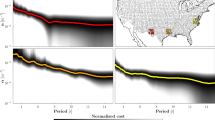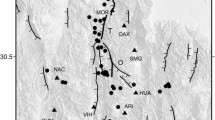Abstract
To determine the near-surface shear wave velocities (Vs) and characterize seismic site conditions in Gangneung, on the east coast of South Korea, passive and active surface waves were recorded at 136 sites. Dispersion images of the Rayleigh waves were obtained by the spatial autocorrelation method and inverted to Vs models. From these one-dimensional Vs models, the depth to the soft bedrock, average Vs at the top of the bedrock, average Vs of the overburden layer, average Vs in the top 30-m interval (Vs 30 ), and average resonance frequency were estimated to be 16 ± 1 m, 481 ± 14 m/s, 254 ± 5 m/s, 374 ± 16 m/s, and 5.5 ± 0.3 Hz, respectively. A lower estimate for Vs 30 and a relatively thick overburden layer make the downtown and agricultural areas in the region more prone to significant ground amplifications. Multiple regression analysis of Vs 30 yielded a correlation coefficient of 0.79 with respect to the variables of elevation and topographic slope. Using this proxy-based empirical relationship, Vs 30 values were computed at 13,583 sites covering the entire city. A microzonation map, constructed based on the Vs 30 data, indicates that the ground in Gangneung is categorized mainly into B (44%), C (39%), and D (15%) National Earthquake Hazards Reduction Program site classes, with minor constituents assigned to the A and E classes.
Similar content being viewed by others
References
Abdel-Fattah, A.K., Kim, K.Y., Fnais, M.S., and Al-Amri, A.M., 2014, Source process and tectonic implication of the January 20, 2007, Odaesan earthquake, South Korea. Physics of the Earth and Planetary Interiors, 229, 72–81.
Aki, K., 1957, Space and time spectra of stationary stochastic waves, with special reference to microtremors. Bulletin of Earthquake Research Institute, 35, 415–456.
Allen, T.I. and Wald, D.J., 2009, On the use of high-resolution topographic data as a proxy for seismic site conditions (VS30). Bulletin of the Seismological Society of America, 99, 935–943.
Ansal, A. and Tñük, G., 2007, Source and site factors in microzonation. The 4th International Conference on Earthquake Geotechnical Engineering, Invited Lectures, Thessaloniki, June 25–28, p. 73–92.
Apostolidis, P., Raptakis, D., Roumelioti, Z., and Pitilakis, K., 2004, Determination of S-wave velocity structure using microtremors and SPAC method applied in Thessaloniki (Greece). Soil Dynamics and Earthquake Engineering, 24, 49–67.
Asten, M.W., 2006, On bias and noise in passive seismic data from finite circular array data processed using SPAC methods. Geophysics, 71, V153–V162.
Asten, M.W., Askan, A., Ekincioglu, E.E., Sisman, F.N., and Ugurhan, B., 2014, Site characterisation in north-western Turkey based on SPAC and HVSR analysis of microtremor noise. Exploration Geophysics, 45, 74–85.
Castellaro, S. and Mulargia, F., 2009, Estimates of Vs30 based on constrained H/V ratio measurements alone. In: Mucciarelli, M., Herak, M., and Cassidy, J. (eds.), Increasing Seismic Safety by Combining Engineering Technologies and Seismological Data, NATO Science for Peace and Security Series C: Environmental Security. Springer, Dubrovnik, p. 86–87.
Chiou, B.-J. and Youngs, R.R., 2008, An NGA model for the average horizontal component of peak ground motion and response spectra. Earthquake Spectra, 24, 173–216.
Chiu, J.M. and Kim, S.G., 2004, Estimation of regional seismic hazard in the Korean Peninsula using historical earthquake data between A.D. 2 and 1995. Bulletin of the Seismological Society of America, 94, 269–284.
Chouet, B., De Luca, G., Milana, G., Dawson, P., Martini, M., and Scarpa, R., 1998, Shallow velocity structure of Stromboli volcano, Italy, derived from small-aperture array measurements of Strombolian tremor. Bulletin of the Seismological Society of America, 88, 653–666.
Eker, A.M., Akgün, H., and Koçkar, M.K., 2012, Local site characterization and seismic zonation study by utilizing active and passive surface wave methods: A case study for the northern side of Ankara, Turkey. Engineering Geology, 151, 64–81.
European standard (EN), 2004, Eurocode 8: Design of Structures for Earthquake Resistance, Part 1: General Rules, Seismic Actions and Rules for Buildings. The European Union Committee for Standardization, Brussels, 229 p.
Federal Emergency Management Agency (FEMA), 1995, 1994 NEHRP Recommended Provisions for Seismic Regulations of New Buildings; Part I, Provisions. FEMA 222A, National Earthquake Hazard Reduction Program, Federal Emergency Management Agency, Washington, D.C., 271 p.
Federal Emergency Management Agency (FEMA), 2003, Recommended Provisions for Seismic Regulations for New Buildings and Other Structures, Part 1: Provisions. Report No. FEMA-450, Building Seismic Safety Council (BSSC), Federal Emergency Management Agency, Washington, D.C., 303 p.
Federal Emergency Management Agency (FEMA), 2006, Risk management series: Designing for Earthquakes. FEMA454, Washington, D.C., 10-8 p.
Haskell, N.A., 1953, The dispersion of surface waves on multilayered media. Bulletin of the Seismological Society of America, 43, 17–34.
Hayashi, K., Inazaki, T., and Suzuki H., 2006, Buried incised-channels delineation using microtremor array measurements at Soka and Misato Cities in Saitama Prefecture. Butsuri-Tansa, 57, 309–325. (in Japanese with English abstract)
Houng, S.E. and Hong, T.K., 2013, Probabilistic analysis of the Korean historical earthquake records. Bulletin of the Seismological Society of America, 103, 2782–2796.
International Code Council (ICC), 1997, 1997 Uniform Building Code: Volume 2-Structural Engineering Design Provisions. International Conference of Building Officials, Whittier, California, 492 p.
International Code Council (ICC), 2000, 2000 International Building Code (IBC). International Code Council, Country Club Hills, Illinois, 756 p.
International Code Council (ICC), 2003, 2003 International Building Code (IBC). International Code Council, Falls Church, Virginia, 660 p.
Isaaks, E.H. and Srivastava, R.M., 1989, An Introduction to Applied Geostatistics. Oxford University Press, New York, 561 p.
Jo, N. and Baag, C.-E., 2007, The 20 January 2007, Mw 4.5, Odaesan, Korea, earthquake. Geosciences Journal, 11, 51–58.
Kang, T.-S. and Baag, C.-E., 2004, The 29 May 2004, Mw=5.1, offshore Uljin earthquake, Korea. Geosciences Journal, 8, 115–123.
Keçeli, A., 2012, Soil parameters which can be determined with seismic velocities. Jeofizka, 16, 17–29.
Kihm, Y.H. and Hwang, J.H., 2011, Geological Report of Gangneung- Jumunjin Sheets (1:50,000). Korea Institute of Geosciences and Mineral Resources, Daejeon, Korea, 76 p.
Kim, K.Y., Ali, A., Jung, J., and Kim, C., 2015, Site Classification for Seismic-Hazard Assessment Using Geophysical Methods. CATER 2012-8040, Korea Meteorological Administration, Seoul, 131 p. (in Korean with English abstract)
Kim, K.Y. and Hong, M., 2012, Shear-wave velocity structure of Jeju Island, Korea. Geosciences Journal, 16, 35–45.
KMA, 2008, 2008 Annual Report on Seismic Activities in Korea. Korea Meteorological Administration, Seoul, 148 p. (in Korean)
Korean Ministry of Environment (KME), 2014, Land Cover Map (2008–2010). http://egis.me.go.kr/ewebgis/webgis.jsp (accessed January 7, 2014).
Korean Rural Community Corporation (KRC), 2014, Rural Groundwater Net. https://www.groundwater.or.kr (accessed January 3, 2014).
Korean Society for Construction Advancement (KSCA), 1997, Standard Quality per Unit for Construction Work, 1416 p. (in Korean)
Lee, C.-T., Cheng, C.-T., Liao, C.-W., and Tsai, Y.-B., 2001, Site classification of Taiwan free-field strong-motion stations. Bulletin of the Seismological Society of America, 91, 1283–1297.
Ling, S. and Okada, H., 1993, An extended use of the spatial autocorrelation method for the estimation of geologic structure using microtremors. Proceedings of the 89th SEGJ Conference, p. 44–49. (in Japanese)
Mahajan, A.K., Galiana-Merino, J.J., Lindholm, C., Arora, B.R., Mundepi, A.K., Rai, N., and Chauhan, N., 2011, Characterization of the sedimentary cover at the Himalayan foothills using active and passive seismic techniques. Journal of Applied Geophysics, 73, 196–206.
Marquardt, C.W., 1963, An algorithm for least square estimation of nonlinear parameters. Journal of the Society for Industrial and Applied Mathematics, 11, 431–441.
Ministry of Construction and Transportation (MOCT), 1997, Korean Seismic Design Standard. Ministry of Construction and Transportation, Seoul, 492 p. (in Korean)
Ministry of Land, Infrastructure and Transportation (MOLIT), 2014, Geotechnical Information Portal System. Ministry of Land, Infrastructure and Transportation. http://www.geoinfo.or.kr (accessed January 4, 2014).
Okada, H., 2003, The microtremor survey method. Geophysical Monograph Series Number 12, Society of Exploration Geophysicists, Tulsa, 135 p.
Olona, J., Pulgar, A.J., Fernández-Viejo, G., López-Fernández, C., and González-Cortina, J.M., 2010, Weathering variations in a granitic massif and related geotechnical properties through seismic and electrical resistivity methods. Near Surface Geophysics, 8, 585–599.
Pan, Y., Xia, J., Gao, L., Shen, C., and Zeng, C., 2013, Calculation of Rayleigh-wave phase velocities due to models with a highvelocity surface layer. Journal of Applied Geophysics, 96, 1–6.
Park, C.B., Miller, R.D., Ryden, N., Xia, J., and Ivanov, J., 2005, Combined use of active and passive surface waves. Journal of Environmental & Engineering Geophysics, 10, 323–334.
Parolai, S., Richwalski, S.M., Milkereit, C., and Fäh, D., 2006, S-wave velocity profiles for earthquake engineering purposes for the Cologne Area (Germany). Bulletin of Earthquake Engineering, 4, 65–94.
Pilz, M., Parolai, S., Picozzi, M., Wang, R., Leyton, F., Campos, J., and Zschau, J., 2010, Shear wave velocity model of the Santiago de Chile basin derived from ambient noise measurements: a comparison of proxies for seismic site conditions and amplification. Geophysical Journal International, 182, 355–367.
Poovardom, N. and Plalinyot, P., 2013, Site characterization in the greater Bangkok area by microtremor observations. Journal of Earthquake Engineering, 17, 209–226.
Romero, S. and Rix, G.J., 2001, Regional variations in near-surface shear wave velocity in the greater Memphis area. Engineering Geology, 62, 137–158.
Scasserra, G., Stewart, J.P., Kayen, R.E., and Lanzo, G., 2009, Database for earthquake strong motion studies in Italy. Journal of Earthquake Engineering, 13, 852–881.
Schwab, F., 1970, Surface-wave dispersion computations, Knopoff’s method. Bulletin of the Seismological Society of America, 60, 1491–1520.
Thompson, E.M. and Wald, D.J., 2012, Developing Vs30 site-condition maps by combining observations with geologic and topographic constraints. 15th World Conference on Earthquake Engineering (WCEE), Lisbon, September 24–28, 9 p.
Thomson, W.T., 1950, Transmission of elastic waves through a stratified solid, analytical results. Journal of Applied Physics, 21, 89–93.
Wald, D.J. and Allen, T.I., 2007, Topographic slope as a proxy for seismic site conditions and amplification. Bulletin of the Seismological Society of America, 97, 1379–1395.
Wald, D.J., McWhirter, L., Thompson, E.M., and Hering, A.S., 2011, A new strategy for developing VS30 maps. 4th IASPEI/IAEE International Symposium on Effects of Surface Geology on Seismic Motion, Santa Barbara, Aug. 23–26, p. 1–12.
Wills, C.J. and Clahan, K.B., 2006, Developing a map of geologically defined site-condition categories for California. Bulletin of the Seismological Society of America, 96, 1483–1501.
Xia, J., Miller, R.D., and Park, C.B., 1999, Estimation of near-surface shear-wave velocity by inversion of Rayleigh waves. Geophysics, 64, 691–700.
Author information
Authors and Affiliations
Corresponding author
Rights and permissions
About this article
Cite this article
Ali, A., Kim, K.Y. Seismic site conditions in Gangneung, Korea, based on Rayleigh-wave dispersion curves and topographic data. Geosci J 20, 781–791 (2016). https://doi.org/10.1007/s12303-016-0013-1
Received:
Accepted:
Published:
Issue Date:
DOI: https://doi.org/10.1007/s12303-016-0013-1




